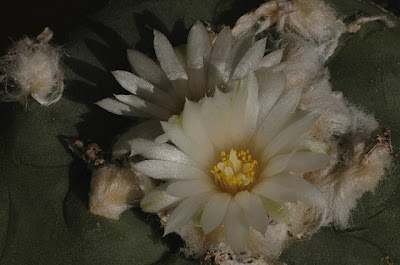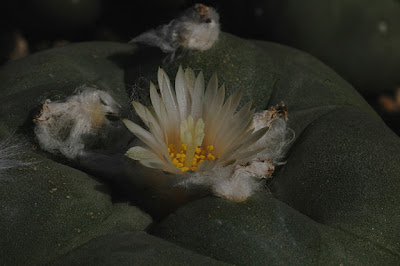Several of my plants are flowering right now, including many of the large undetermined Lophophora plants I bought earlier this spring. The plants were sold as Lophophora williamsii but body morphology and flower color suggest that many of them are actually Lophophora diffusa. Even though they flower, it is still difficult to determine the species of some of the plants conclusively, so I suspect them to be of hybrid origin. A handful of flower photos are included below.





Wednesday, May 14, 2008
Lophophora flower fest
Flowering Echinocereus reichenbachii
I have been growing Echinocereus reichenbachii in my coldhouse for a while but never seen any flowers until last week. Several of the plants flowered for the first time - an impressive sight.
Flowering Echinocereus reichenbachii
The flowers are excessively beautiful with their silvery pink to magenta petals, bright yellow anthers, and the fresh green stigma in the center of it all.
Echinocereus reichenbachii flower, close-up
The flowers seem rather variable both in the number and color of the petals. The flower pictured below has fewer, larger, and darker petals than the one above.
E. reichenbachii flower with a slightly darker hue
I outcrossed the flowers and hope for seeds next year.
Sunday, May 04, 2008
Time-lapse video of a flowering Lophophora williamsii
I've been away on a short vacation and it seems my grafted Lophophora williamsii (SB 854; Starr Co, Tx) has spent its "lone time" wisely and grown three flowers.
Lophophora williamsii displaying three flowers
Even though the flowers were already quite open when I returned home, I decided to attempt a time-lapse video showing the flowers open fully. Unfortunately I forgot to disable the cameras autofocus function which gives the video a shaky appearance as the camera continuously changes focus slightly.
That being said, I'm impressed by the agility of the Lophophora stamens - they seem almost to be dancing around the style. A dazzling display of thigmotropic behavior is shown 50some seconds into the video; the stamens are disturbed and fold rapidly in around the style only to resume their perpetual wiggle shortly after. In contrast to this Epithelantha micromeris v. greggii stamens never seem to move during flowering.
I yet haven't managed to create a time-lapse video that is fully satisfying (the flower must be shown from bud to full bloom, the image must not shake/autofocus, no drop outs must occur in the stream of images, etc). I'll keep trying though, but I'll bet that when everything is set for the perfect time-lapse the shutter of my good old D70 gives up the ghost just before the shoot is finished ;-)
The photos for the time-lapse were shot at intervals of 15 seconds during a period of 160 minutes. The pictures are played back at a rate of 10 frames per second, i.e. the flowering is speed up by a factor of 150 resulting in a video running for 64 seconds.
Time-lapse video of a flowering Epithelantha micromeris v. greggii
Most of my coldhouse grown Epithelantha micromeris v. greggii (Cuesta la Muralla, Coahuila, Mexico) flowered big time this week. The plants were started from seed in 2004 and are flowering for the first time.
Flowering Epithelantha micromeris v. greggii
The small creamy, off-white flowers are not spectacular but still quite a beautiful sight, especially when several are blooming at the same time. The following time-lapse video shows a flower going from bud to full bloom.
The pictures used for the time-lapse were taken every 15 seconds over a two hour period. The pictures are played back at a rate of 10 frames per second, i.e. the flowering is speed up by a factor of 150 resulting in a 48 second video. The camera was placed on an old wooden floor resulting in a couple of "wobbly" sequences. The photos were taken using natural light only, the shifting light levels are caused by drifting clouds.
I attempted to cross-pollinate several of the plants and are hoping for seeds next year.
All Time Most Popular Posts
-
Lophophora williamsii (peyote) populations have diminished in large areas of South Texas where peyoteros harvest the cactus for ceremonial ...
-
On various occasions I've been asked what growing media I'm using for my cactus plants. I don't have a set soil mix recipe as su...
-
Below is a list of retailers/nurseries selling cactus seed and plants. I've only listed vendors I've done business with. If you ar...
-
Most cacti are easily grown from seed - and with a little patience and care they can be grown into beautiful plants. Lophophora williamsi...
-
In last month’s post on the troubled Texan peyoteros I referred to Anderson’s article on the peyote situation in Texas. Given the importanc...
-
Yet another slightly off topic and probably not entirely politically correct post, but I couldn’t help noticing the similarity of my monstr...
-
Flowering stand of San Pedro cacti (Trichocereus pachanoi) To me the main draw of the San Pedro cactus ( Trichocereus pachanoi (syn. Ech...
-
In the June 2008 issue of the Cactus & Co magazine Jaroslav Šnicer, Jaroslav Bohata, and Vojtěch Myšák described a new Lophophora spec...
-
There seems to be an increased focus on the alarming Texas peyote situation. A couple of weeks ago the Houston Press published a mournful, i...
-
I spent two weeks working in Delhi, India during January. I had one weekend off and had planned to spend it in Delhi at my own leisure, but ...


















